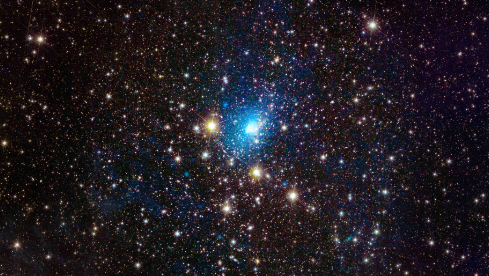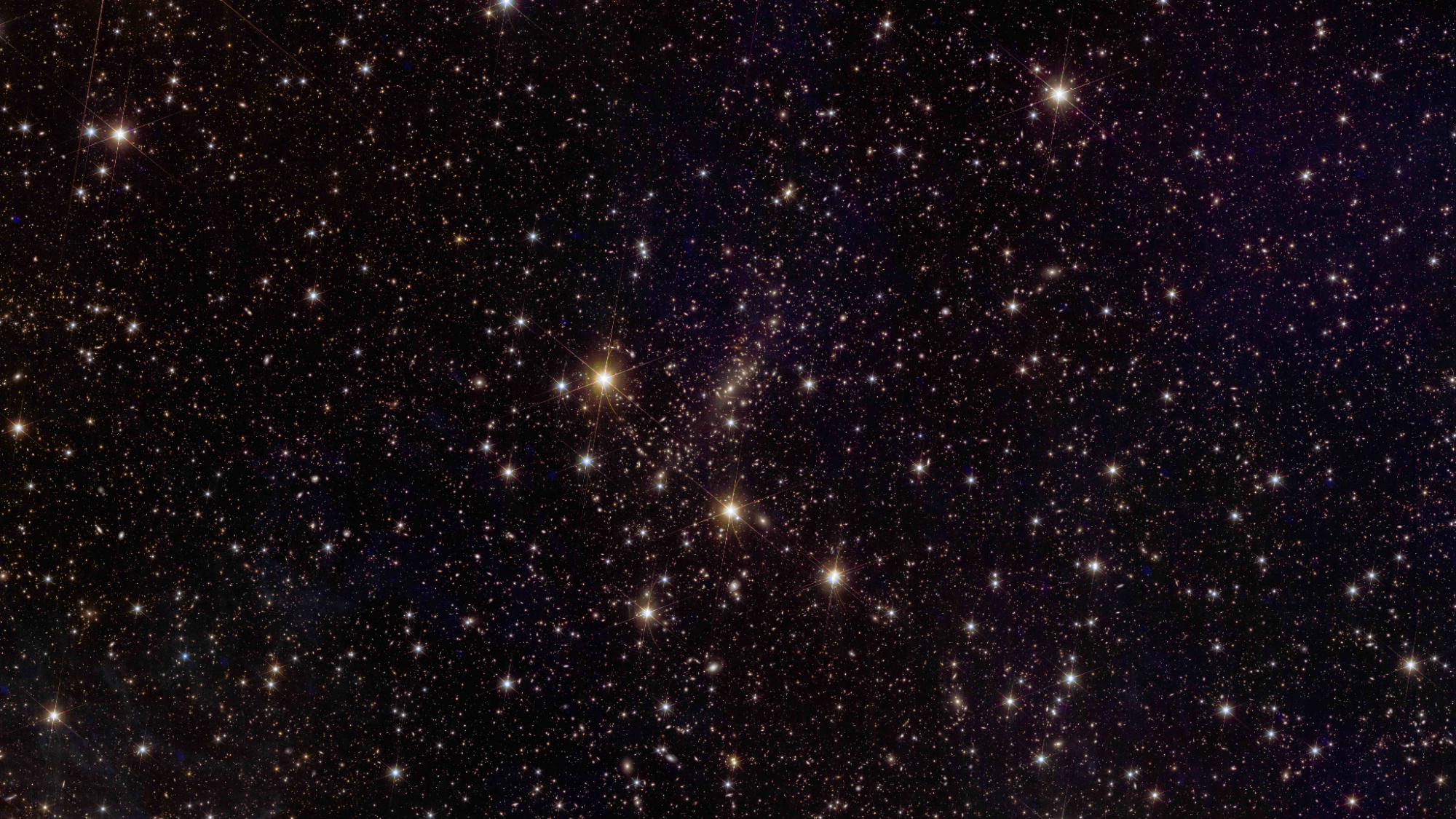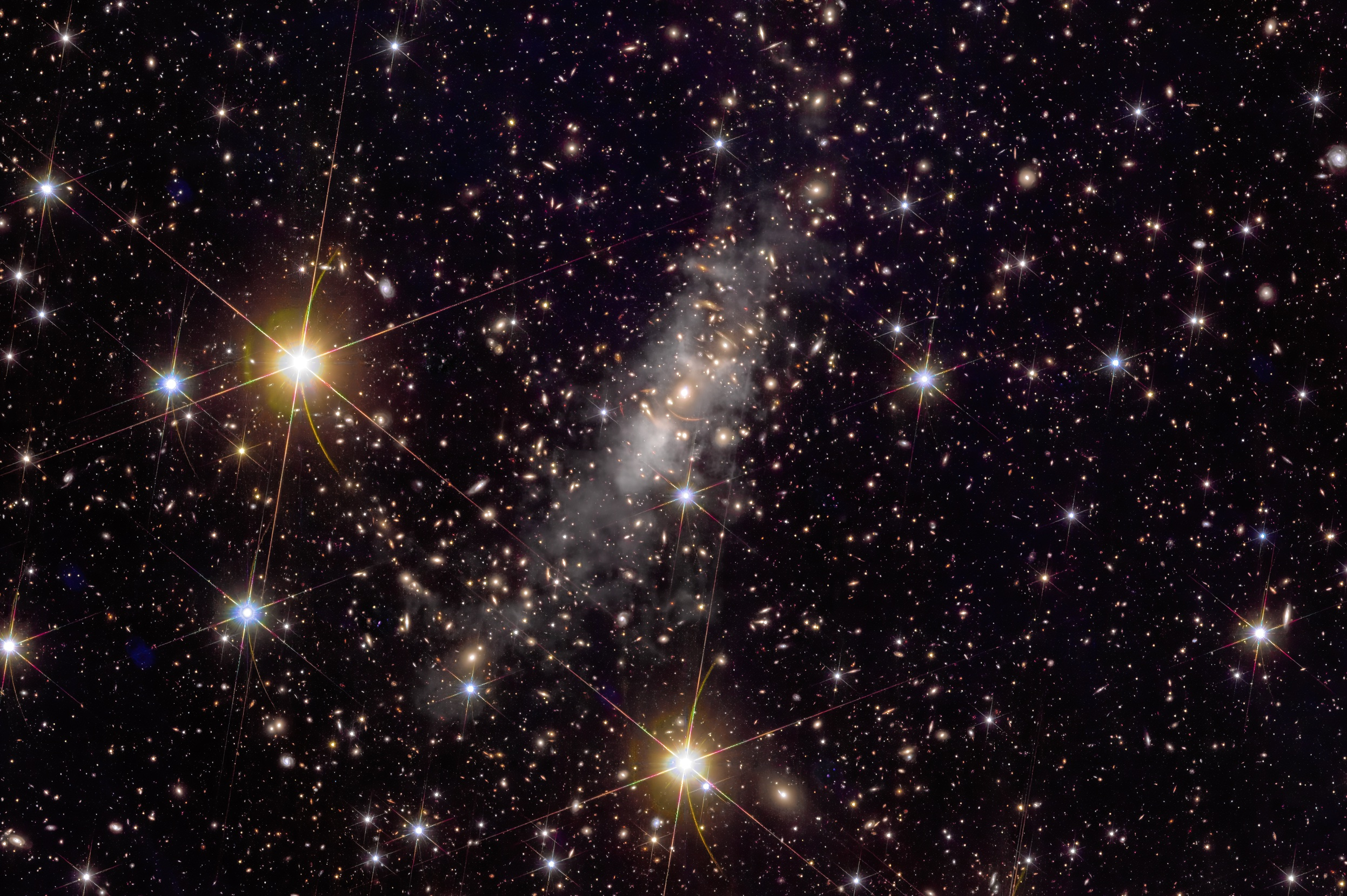X-rays reveal secret gas in huge and distant galaxy cluster
The gas is so hot, between 10 million and 100 million degrees Celsius, that it radiates in powerful X-rays.

By combining a new image of a giant galaxy cluster with older X-ray data, scientists at the European Space Agency (ESA) have demonstrated how the cluster's galaxies are suffused by huge amounts of gas that can reach scorching temperatures up to 100 million degrees Celsius (180 million degrees Fahrenheit).
The galaxy cluster, Abell 2390, was imaged recently by ESA's Euclid mission, designed to study dark matter and dark energy by probing gravitational lensing occurrences in galaxy clusters. Because these clusters contain so much mass — up to ten trillion solar masses worth — they're able to bend the fabric of space-time around them, warping it to such a degree that light from distant galaxies in the background becomes highly magnified. It's as though you're looking at them through a gigantic magnifying lens. If we zoom in on the core of Abell 2390, we see that the lensing effect is at its most pronounced, stretching, warping and amplifying the light of other galaxies billions of light-years farther away.
Most of a galaxy cluster's mass, though, isn't found in its galaxies. In fact, they contribute barely 5% of the cluster's overall mass. The largest contributors are the hot intracluster gas between the galaxies in the cluster, which makes up about 15% of the cluster’s mass, and invisible dark matter, which forms a whopping 80% of Abell 2390's bulk.
While we can infer dark matter's presence from the degree of gravitational lensing, we can't see it. We can see the intracluster gas, however, thanks to the X-ray vision of ESA's XMM-Newton mission, which detected this gas in Abell 2390 all the way back in 2001.
Related: X-ray spacecraft reveals odd 'Cloverleaf' radio circle in new light (image)
In this new composite view, we see Euclid's image of Abell 2390, which lies 2.7 billion light-years away from us in the direction of the constellation of Pegasus, the Winged Horse. Euclid's image is incredible; it's a very wide-field image, the field of view through its 1.2-meter (3.9-foot) aperture telescope spanning 1.25 by 0.73 square degrees. The image encompasses some 50,000 galaxies, many of which are actually not in Abell 2390, which is seen at the center of the image and itself contains thousands of galaxies. The most distant background galaxies, far beyond even Abell 2390, appear red because their light has been redshifted due to the expansion of the universe. A handful of foreground stars can be seen as well, singled out by their six-pronged diffraction spikes.

Overlain on Euclid's visible-light view is XMM-Newton's detection of X-ray emission from the cluster. This is produced by ionized hydrogen gas with a temperature ranging between 10 million and 100 million degrees Celsius (18 million to 180 million degrees F). At such temperatures, the gas radiates only in X-rays, so what we see here as the blue glow is a false color representation of the X-ray signal. The X-rays are brightest towards the center of the cluster, where the intracluster gas is hottest and at its most concentrated.
Get the Space.com Newsletter
Breaking space news, the latest updates on rocket launches, skywatching events and more!
Right at the heart of Abell 2390, amid all this searingly hot gas, is what is known as the brightest cluster galaxy, or BCG. Every large galaxy cluster has one of these — in the nearby Virgo Cluster, the BCG is Messier 87. In other words, the BCG is a giant elliptical galaxy with an active supermassive black hole at its core, feedback from which — in the form of radiation outflows — can heat the intracluster gas and even prevent star formation in the cluster's other galaxies.
In results published earlier this year, observations of Abell 2390's BCG with the Atacama Large Millimeter/submillimeter Array (ALMA) in Chile revealed a gigantic plume containing over 10 billion solar masses worth of molecular gas stretching nearly 50,000 light-years away from the BCG. Scientists believe the plume to possibly be the result of a gravitational disturbance resulting either from another galaxy passing close to, or even merging with, the BCG in the crowded environs of Abell 2390. The disturbance caused by such an event could be sufficient to cause the BCG and its surrounding dark matter halo to become decoupled, or separated, from the intra-cluster gas, leaving a trail of molecular gas like what ALMA found in the plume.

Meanwhile, at radio wavelengths, the Low Frequency Array (LOFAR) in Europe has found various lobes of radio-emitting particles around Abell 2390's BCG. These lobes have been produced by an intermittent but powerful jet emanating from the active black hole in the center of the BCG. The lobes are of different ages, and are pointing in different directions, implying that the jet — and therefore the orientation of the black hole and its surrounding accretion disk of gas that feeds the jet — is precessing. In other words, it is wobbling in a regular fashion, the jet tracing out a circle above the black hole’s rotational axis.
The jets can heat the surrounding intra-cluster medium, but currently they appear to be in a quiescent phase and the hot X-ray emitting gas is slowly cooling and falling back onto the BCG and other galaxies in the cluster, where the cooling gas could potentially form new stars.
One new innovation from Euclid is the ability to detect the faint stellar glow of billions of stars ripped from their galaxies by gravitational tidal forces at work in the tumultuous environment of the cluster. Individually the stars are far too faint to be observed at such huge distances, but collectively, they contribute to an eerie glow, which has been enhanced in the Euclid image. By following where these rogue intergalactic stars congregate, drawn in by gravity, astronomers can trace where the dark matter lies in Abell 2390.
Euclid's first images of the universe, including one of Abell 2390, were released in May. The spacecraft, which launched back in July 2023, has now embarked on a six-year mission to map the dark universe by observing billions of galaxies and galaxy clusters spread across 10 billion years of cosmic history.
Join our Space Forums to keep talking space on the latest missions, night sky and more! And if you have a news tip, correction or comment, let us know at: community@space.com.

Keith Cooper is a freelance science journalist and editor in the United Kingdom, and has a degree in physics and astrophysics from the University of Manchester. He's the author of "The Contact Paradox: Challenging Our Assumptions in the Search for Extraterrestrial Intelligence" (Bloomsbury Sigma, 2020) and has written articles on astronomy, space, physics and astrobiology for a multitude of magazines and websites.
-
pennyturtle If something on Earth was "... suffused by huge amounts of gas that can reach scorching temperatures up to 100 million degrees Celsius" it would be described as a plasma, the purview of plasma physicists and electrical engineers. They would potentially link the phenomenon with the associated magnetic and electric fields that contain and maintain that plasma.Reply
What would it mean for theoretical cosmologists? With every observation being attempted to be explained by gravity-only models (yeah dark matter, I'm talking to you), they begin to seem like the man with a hammer, for whom everything is a nail. Well, screw that... -
Catastrophe And, would you believe it, if this "secret gas" turned out to be hydrogen, which accounts for aboutReply
74% of the total mass, together with helium, at about 24%?
Cat :)









